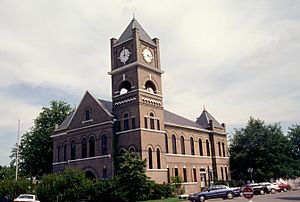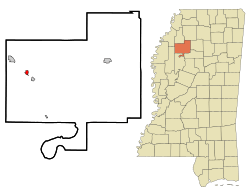Sumner, Mississippi facts for kids
Quick facts for kids
Sumner, Mississippi
|
|
|---|---|

Tallahatchie County Courthouse in Sumner
|
|

Location of Sumner, Mississippi
|
|
| Country | United States |
| State | Mississippi |
| County | Tallahatchie |
| Area | |
| • Total | 0.55 sq mi (1.42 km2) |
| • Land | 0.55 sq mi (1.42 km2) |
| • Water | 0.00 sq mi (0.00 km2) |
| Elevation | 151 ft (46 m) |
| Population
(2020)
|
|
| • Total | 278 |
| • Density | 505.45/sq mi (195.18/km2) |
| Time zone | UTC-6 (Central (CST)) |
| • Summer (DST) | UTC-5 (CDT) |
| ZIP code |
38957
|
| Area code(s) | 662 |
| FIPS code | 28-71520 |
| GNIS feature ID | 2406688 |
Sumner is a small town in Tallahatchie County, Mississippi. In 2020, about 278 people lived there. Sumner is special because it is one of two county seats for Tallahatchie County. A county seat is like a main town where the county government offices are located.
Sumner is on the west side of the county, near the Tallahatchie River. The river flows from north to south through the county. The other county seat is Charleston, which is east of the river. Charleston was the first county seat and is a bit bigger than Sumner.
The courthouse in Sumner has been fixed up. It now has the Emmett Till Interpretive Center. This center opened in 2012. It helps people learn about Emmett Till and his story. In 2023, the courthouse and center became part of the Emmett Till and Mamie Till-Mobley National Monument.
Contents
Discovering Sumner's Location
Sumner is located at coordinates 33°58′12″N 90°22′11″W / 33.97000°N 90.36972°W.
The United States Census Bureau says that the town covers about 0.6 square miles (1.42 square kilometers). All of this area is land.
Sumner's Past: A Look Back
Early Days and Native Americans
The land around the Tallahatchie River was once covered in thick forests and swamps. It was home to the Choctaw Nation. The Choctaw were one of the main Native American groups in the Southeast. In the 1830s, the U.S. government made them move to Indian Territory. This happened because of the Indian Removal Act.
Founding and Growth of the Town
After the Choctaw moved, the U.S. government sold the land. European-American families began to settle there. The Sumner family was among the first settlers. These early settlers worked hard to clear the land. They removed trees and plants to make space for farms.
Wealthy landowners used the labor of enslaved African Americans. These enslaved people grew cotton. Cotton became the most important crop. It was the main source of money for the area for many years.
Sumner officially became a town in 1900. It was named after its founder, Joseph Burton Sumner. He was also the town's first mayor.
Two County Seats: A Unique Setup
In 1902, Tallahatchie County was divided into two areas. This was because the Tallahatchie River made it hard to travel across the county. Charleston was the first county seat. It was on the east side of the river. Sumner was chosen to be the county seat for the western part of the county.
The Tallahatchie County Courthouse in Sumner was built in 1902. Joseph B. Sumner gave the land for both the courthouse and the jail. The courthouse burned down in 1908 but was rebuilt in 1909. Cotton farming stayed very important in the area. Sumner served as the main market town for its district.
The Emmett Till Story and Its Impact
The courthouse in Sumner is famous for a sad event in 1955. It was where a trial took place for the death of Emmett Till. Emmett Till was a teenage African-American boy from Chicago. His death and the trial caused a lot of anger and led to many people speaking out. He became an important symbol for the Civil Rights Movement. This movement worked to gain equal rights for African Americans.
In 1990, the Mississippi Department of Archives and History named the courthouse a state landmark.
Remembering History: The Interpretive Center
In 2007, local leaders formed the Emmett Till Memorial Commission. They wanted to honor Emmett Till and help bring people together. The commission formally apologized to Emmett Till's family. They also decided to restore the Sumner County Courthouse. Their goal was to create a center there to teach people about Emmett Till.
The Emmett Till Interpretive Center opened in 2012. It offers workshops and events. These activities help people learn about history and art.
Sumner's People: Demographics
Sumner had its largest population in 1940. After that, many African-American residents left the town and county. They moved to places like California and the West Coast. This happened during and after World War II. They found jobs in factories that made things for the war. They also wanted to escape unfair treatment and violence in the South.
Also, new machines meant that fewer farm workers were needed. African Americans moving from Sumner were part of the Great Migration. This was when about 5 million Black people moved out of the Deep South between 1940 and 1970. Many small towns have seen their populations shrink since then.
| Historical population | |||
|---|---|---|---|
| Census | Pop. | %± | |
| 1910 | 364 | — | |
| 1920 | 613 | 68.4% | |
| 1930 | 618 | 0.8% | |
| 1940 | 662 | 7.1% | |
| 1950 | 550 | −16.9% | |
| 1960 | 551 | 0.2% | |
| 1970 | 533 | −3.3% | |
| 1980 | 452 | −15.2% | |
| 1990 | 368 | −18.6% | |
| 2000 | 407 | 10.6% | |
| 2010 | 316 | −22.4% | |
| 2020 | 278 | −12.0% | |
| U.S. Decennial Census | |||
In 2000, there were 407 people living in Sumner. There were 148 households and 105 families. The town had about 726.5 people per square mile.
The people living in Sumner were from different backgrounds. About 58% were White, and 39% were African American. A small number were Asian or from two or more races. Less than 1% were Hispanic or Latino.
About 31.8% of households had children under 18. Many households were married couples living together (47.3%). Some households had a female head with no husband (20.3%). About 23% of households were single people. About 12.8% of households had someone 65 or older living alone.
The average household had 2.67 people. The average family had 3.14 people.
The population was spread out by age. About 27.5% were under 18. About 17% were 65 or older. The average age was 40 years old.
The median income for a household was $25,000. For a family, it was $35,208. About 25.2% of families and 37.2% of the total population lived below the poverty line. This included almost half of those under 18.
Famous People from Sumner
- William Eggleston is a world-famous color photographer. He grew up on a farm in Sumner.
- Red Nelson was a well-known blues singer. He was born in Sumner in 1907.
Learning in Sumner: Education
The West Tallahatchie School District serves the town of Sumner. Students in Sumner attend R. H. Bearden Elementary School and West Tallahatchie High School.
Before 1988, Sumner Elementary School taught younger students. West District Middle School was for middle schoolers. In 1988, West District Middle became a school for grades 3-8. Sumner Elementary then taught only Kindergarten through grade 2.
Coahoma Community College is the local community college for the area.
Images for kids
See also
 In Spanish: Sumner (Misisipi) para niños
In Spanish: Sumner (Misisipi) para niños




